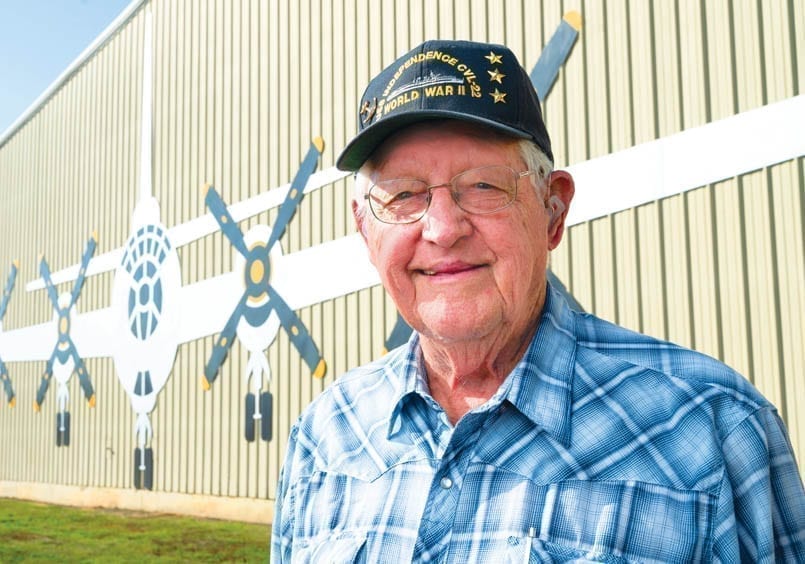29 Oct 2020 WWII veteran creates mural to honor veterans
by Donna Lampkin Stephens
As a boy, Al Hiegel dreamed of flying, watching the planes take off and land at the old Conway airstrip from his nearby home and from St. Joseph School.
“When I would go upstairs (at school), I could see the airport,” Hiegel, 94, said recently. “That’s all I thought about.”

Nearly 80 years later, his efforts will inspire another generation after he spearheaded the placement of a full-scale replica of the outline of a B-29 Superfortress — a four-engine propeller-driven heavy bomber used by the United States during World War II — on the side of an industrial warehouse at the intersection of Bruce and Harkrider in Conway. It marks his love of flying and the memory of his and so many others’ naval service during World War II.
“I thought about putting it on the building at the (old Conway) airport,” Hiegel said. “There’s a nice building down there, but I would have had to shrink it up some to put it there, and not too many people would see it there.
“But at (Bruce and Harkrider) they say there’s 14,000 cars a day that pass through.”
He told his grandson, Greg Hiegel, about the “beautiful blank canvas” there, and he approached the building’s owner, who gave his permission for the installation. Hiegel said the owner didn’t want to be identified.
Greg remembered the conversation.
“Grandpa said, ‘I’m pretty sure we can fit a B-29 on that thing,’” he remembered. “I had to Google how big it was — 141 feet, 3 inches. The only thing we had to change a little was the tail fin to get it on the building. We tapered it by three feet.”
The B-29 was inspired by Hiegel’s experiences as a sailor during WWII. He left American soil on Feb. 14, 1945, for Hawaii, where he asked to be assigned to an aircraft carrier as a radar operator. His boyhood experience watching the planes in Conway was the inspiration. After boarding the U.S.S. Independence, he and his shipmates joined a multitude of other ships readying for the attack on Okinawa. Those B-29s guarded against Japanese kamikaze pilots who flew suicide missions into enemy targets — usually ships.
“He loved the B-29 Superfortress because that was the plane that protected his team during the war,” Greg said. “They took out the kamikazes.”
Hiegel remembered that during his military service, 1,500 kamikazes came after the fleet.
“I was on the only carrier that did not get hit,” he said. “I was a radar operator, and I always said the reason my ship didn’t take a kamikaze was because we had better radar operators. I loved that airplane because it helped save my life.”
The design at Bruce and Harkrider is a collaboration among Hiegel, Greg (owner of Hiegel Building Solutions), Lucas Strack and H&N Architects and Bruce Baker and WesCon Machining. According to www.hiegelbuildingsolutions.com, the group “designed, created and assembled” the 147 parts and installed approximately 10,000 pop rivets to keep everything in place.
The design is made of galvalume steel.
“We used high-powered earth magnets to hold the pieces in place to get everything exactly right,” said Greg, who supplied a crew of four for the installation. “We drilled and pop-riveted everything into place.”
After returning from his WWII service, Hiegel married his high school sweetheart, Mary. They had three children and were married for 72 years until her 2019 death.
He also earned his pilot’s license and flew recreationally for more than 60 years before taking his final flight at 85. An unknown number of his family, friends and strangers joined him over the years.
“He was always very generous with his time,” Greg said. “People would ask, and he’d tell them, ‘Meet you down at the airport.’ He would take them up. His plane had dual controls, so he’d let the person flying in the passenger seat take over the steering and handling. That gave them a really cool experience, and he’d give them a certificate.”
The B-29 project followed the installation of a plane replica on Hiegel’s 40-foot wide barn a few years ago.
“I had to shorten the wings,” he said. “I did it when I was 90 years old. I had a little bit of help putting it up when the time came to rivet it on the barn, but other than that, I figured it out, painted it and everything.”
The B-29, though, is his gift to the city.
“I enjoy it every time I go by,” Hiegel said. “I just get a kick out of it. It’s one of the best things I’ve ever done.”
While Greg said he thought his grandfather had “finally scratched that itch,” he’s not sure the replica-building is over.
“I don’t think he’s looking at anything else right now, but who knows?” Greg said. “He thinks outside the box on a lot of things.”
- Fits like a glove - December 2, 2025
- Petit Jean: The place for partnerships - December 1, 2025
- Youth of the Month: Emalee Jack Goforth and Bailey Fournier - November 4, 2025








